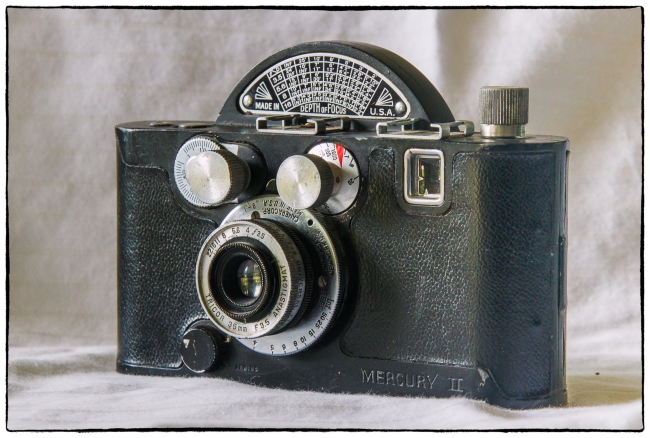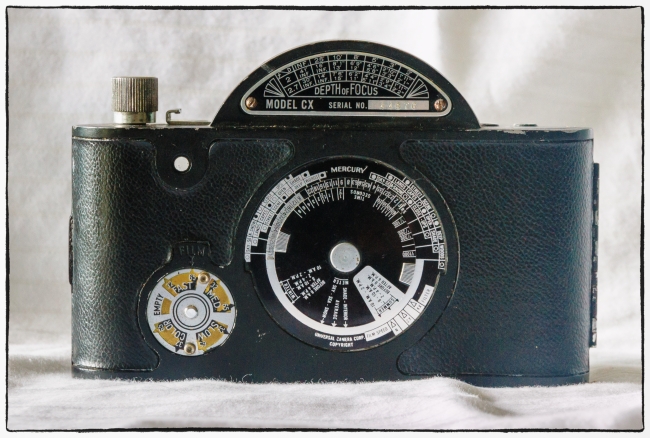I’d been looking for one of these for a while – either the pre-WWII Mercury (often called Mercury I) or the post war Mercury II. One of the foci of my collection is US 35mm cameras, most of which (with the exception of my beloved Retinas and possibly a few Argus’s) I find to be rather weird and wonderful. When I saw pictures of the Mercury I couldn’t help but notice the large hump on top. For those who don’t already know it’s a rotary focal plane shutter and I’d never seen anything like it. When I came across this one for a reasonable price I just had to have it.
As is often the case Mike Eckman has written one of his excellent reviews (see: Universal Mercury II (1946-48)) on it. He provides a short history of the Universal Camera Corporation, gives his thoughts on the camera, offers some tips regarding repairs and shows some photographs he had taken with the camera.
Since Mike has already provided so much information I’ll limit myself to just a few comments.
First the size of the camera surprised me. This is sometimes the case when you’ve only seen pictures of the camera. I recall seeing an Exacta in a nearby photo shop and thinking that it was much larger than I had thought. I also remember seeing a Kodak Bantam Special in the Kodak Museum in Rochester and thinking that it was much smaller than I expected. In the case of the Mercury it’s a lot smaller than I thought it would be.
Second the camera is black. I think it looks good in black, but I doubt that any Mercury every left the factory like this. All those I’ve seen are chrome. This is without doubt some owners paint job. This is possibly because the finish on the Mercury is generally considered to be pretty dismal. In her superb book: The UniveX Story (more about which in a future post) Cynthia Repinski writes:
Generally speaking, the metal finish on the Mercury II lacked the luster and gleam that characterized the Mercury I. The finish of the Mercury II seemed to become dingy and dull within only a short time. Signs of heavy corrosion are extremely common on Mercy II models today, whereas many of the Mercury I models appear almost like new. Some former Universal engineers recalled the inferior finish of the Mercury II was due to the postwar use of magnesium metal in combination with the aluminum allow normally used in die casting the Mercury housings. Magnesium had become quite popular during WWII and was being readily used by many other manufacturing companies in the post war fabrication of their own products. The aluminum alloy used in the production of the Mercury I camera provided a more gleaming appearance than the combination of aluminium and magnesium used in the production of the Mercury II camera.
When I purchased this camera I had no intention of using it. I’m not a fan of half-frame cameras. I thought that I’d just put it alongside such other gorgeously ugly cameras as the Kodak 35RF (which someone once referred to as a camera “only a mother could love”). However, once I had it in my hands I liked the way it felt. The more I look at it the more I like the way it looks (I no longer consider it to be ugly) and I’d like to try taking pictures with it. Unfortunately I can’t. The shutter works, the aperture works, the viewfinder is OK – but unfortunately the focus is completely frozen. I intend to try to “unstick” it though.
Rear view with the rather complex (I have no idea how it works) exposure calculator.


